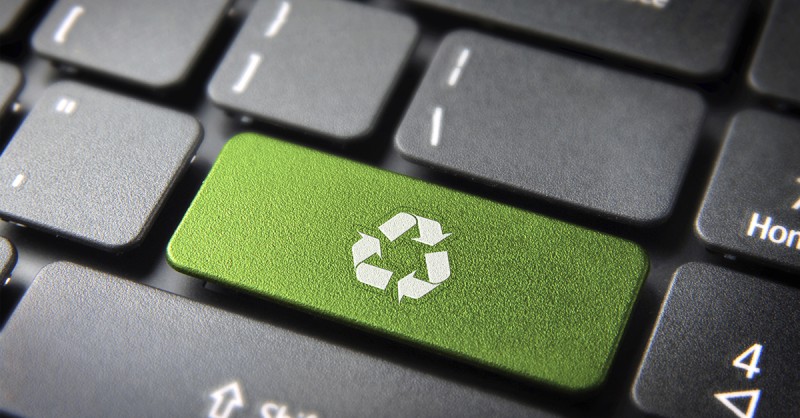The demand for IT, from laptops or printers to complex data centres is constantly growing, and even though each individual device is far less energy-hungry than it was even 3 years ago, this positive development is overcompensated by the sheer amount of devices in place. The pandemic was just the last booster of this development.
So it is high time for a more sustainable IT (Green IT). This involves producing, using, managing, refurbishing, and disposing of IT in a way that minimises its impact on the environment.
Sustainable IT or IT for sustainability?
Why do we need IT so much? Among other things, it’s because data collected (in the right way) can help us move towards a more sustainable world. The problem, however, is that the amount of said data is constantly growing, and with this growth we need more and more energy and other resources to process, analyse and, above all, store it. Technology can help us to increase sustainability and it enables advanced levels of productivity and efficiency. One of the most important tasks of sustainable IT is therefore to develop technologies that help us to make better use of the limited resources we have.
Why does sustainable IT matter?
What we have mentioned above shows that sustainable IT is not only important because it reduces energy consumption and the carbon footprint within the sector. With the right sustainable technologies, IT can also support other sectors in their quest to be greener.
But just how does this work? Here are some concrete examples:
IT in Logistics
While vital to a global economy, logistics is a pretty big polluter, but companies are employing IT to reduce this impact. UPS has implemented On-Road Integrated Optimization and Navigation (ORION), an AI system that is designed to optimize routes for deliveries. It constantly recalculates routes using real-time traffic data and changing orders. Since its launch in 2012, it has saved around 100 million miles (160,934,400 kilometres).
More sustainable retail
Handheld devices in stores help to keep stock more accurately and reduce unnecessary deliveries in the retail sector. At the same time, online shopping has reduced the number of people driving to stores for their shopping, and IoT devices are helping companies track their products across the entire supply chain to maintain quality and reduce waste.
Green IT? How?
Manufacturing
Starting from scratch, major IT manufacturers such as Lenovo, APC and Microsoft have begun to make changes in the manufacturing process to lower emissions. Around 10-17% of Lenovo’s server products are made up of consumer recycled plastics, and they have begun to use biotechnology as a basis for creating their packaging. Other measures include welding at lower temperatures to make large-scale energy savings. APC has ensured that over 60,000 components sold in Europe were free of toxic earth metals such as cadmium, mercury and hexavalent chromium. Microsoft created a Sustainable Transformation Model to help provide a concrete framework for manufacturing companies and businesses to make all of their processes more sustainable.
Cloud
Arguably one of the most important technologies contributing to reducing the carbon footprint is cloud computing. The ability to scale and eliminate physical assets allows businesses to significantly reduce their carbon footprint. Of course, data centres of the hyper scalers use enormous amounts of energy, require extensive cooling and space. However, it is just a fraction of what would be needed if all computing power and storage would be managed on an individual company level. Plus, they no longer need to worry about maintaining, removing or recycling physical hardware. Scaling, in turn, means that companies do not need to over-provision and instead only use and pay for what they really need.
Cooling
The recent increase in the number of employees working remotely has contributed to a significant increase in data volumes. There is no doubt, therefore, that the performance and efficiency of data centres is crucial. As mentioned above, one of the main challenges in this context is cooling.
More and more new technologies and ideas are emerging on how to cool data centres in a more sustainable way. Creating cold and hot aisles and using Variable Frequency Drives (VFDs) are still not enough. The location of data centres is playing an important role, too. Building them in cooler climates allows the use of cold outside air to cool the interior. However, the most common idea for more sustainable data centre cooling is to use liquid instead of air.
Liquid is more efficient at absorbing and transferring heat than air. Moreover, a major advantage of using liquid is targeted cooling, which is virtually impossible with air cooling. Although more equipment and more complex technology is required, liquid cooling is able to reach selected areas (for example, inside servers).
Equipment
IT products are part of the sustainability issues each company is facing. This is why it is advisable to introduce the right criteria at the purchasing stage. The products and equipment selected should be durable, have a long service life and the lowest possible energy consumption. It is also worth considering the possibility of upgrading, repairing or disposing of them at a later date. Furthermore, company policy should force the question of whether the new equipment is really needed. And if an update is unavoidable, the current equipment should be refurbished and remarketed if possible.
Sustainable IT can take many shapes and forms; improved packaging is one simple way in which the industry can reduce its environmental impact. Learn more on this at ALSO.


